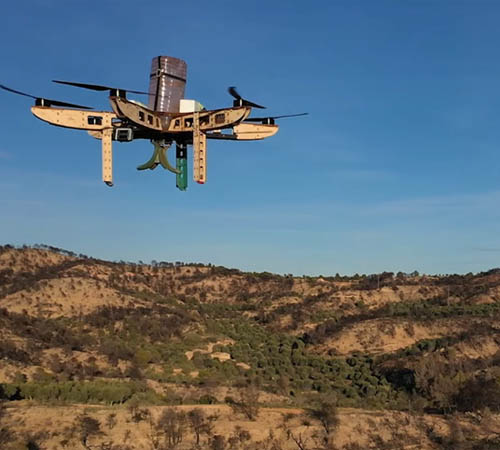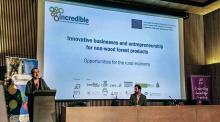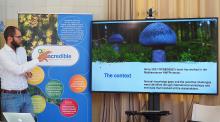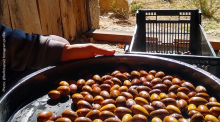Innovation from the skies: Drone technology for dispersion of pelletized seeds for reforestation

Dronecoria, founded by Lot Amorós of Elche, Spain, is applying drone technology for dispersion of pelletized seeds for reforestation. He and his team were awarded $20,000 for their innovative development of a seed-coating method, which is critical for their approach to large scale, low-cost direct sowing of native seeds for ecosystem restoration.
Conservation X Labs is a US-based technology and innovation company that “spurs innovative solutions to stop the extinction crisis by harnessing genius solutions” from all over our planet.
Mr. Amorós who presented his project at the cross-cutting seminar Innovative Businesses and Entrepreneurship in Non-Wood Forest Products, 27 and 28 February 2020 in Barcelona, brought one of his light-weight and open-source drone models designed for the dispersion of seeds for global reforestation. Among the challenges they face is the design of the seed coat that must offer both protection from the elements and predators, and help provide nutrition for emerging seedlings.
As he explained, the technology of seed coating is complex and highly guarded in the agri-food sector. Their goal is to formulate ingredients and methods that are reliable and open sourced for world-wide, low-cost application in direct seeding of many plant and tree species for reforestation. This will reduce costs and limitations associated with transplanting of container seedlings, and open up possibilities for landscape level restoration beyond monoculture plantations.
The “Powerful Seeds” approach incorporates three basic technologies: 1) Priming, 2) Seed Coating and 3) Mycorrhizal Inoculation to support plant fungal symbiosis at the time of germination.
Priming of seeds to improve germination is being carried out by Daniel Calatayud of Semillistas in Granada. He experiments with priming techniques using many native seeds from the region. His work demonstrates that priming of seeds prior to direct sowing can prepare them for emergence even when rainfall is scarce. Unreliable germination and emergence are serious obstacles to direct seeding. More than 10,000 seeds were planted in the autumn of 2020 and germination has begun.
For the 2020 pilot project in the Sierra de Lujár of Andalusia, the mycorrhizal inoculations were coordinated by Christine Fischer of CTFC. Within the seed coats of Quercus seeds, spores of the summer truffle Tuber aestivum have been included. Truffle experts from La Rioja, Navarra, Soria and Catalonia have assisted in collection of truffles this past summer. Seedling survival and mycorrhizal status will be evaluated over this coming year. Stay tuned!















 El proyecto INCREDIBLE recibe fondos del programa Horizon 2020 de la Comisión Europea en el marco del acuerdo de subvención Nº 774.632.
El proyecto INCREDIBLE recibe fondos del programa Horizon 2020 de la Comisión Europea en el marco del acuerdo de subvención Nº 774.632.
Comentarios (13221)
This is exactly why it is actually better which you can related exploration well before delivering. It will be possible to publish bigger report using this method.
Rent a car baku
buy prednisolone 5mg omnacortil 10mg brand omnacortil 20mg for sale
buy ed pills online: male ed pills - ed pills otc
omnacortil 5mg cheap omnacortil cheap omnacortil 20mg canada
После долгих лет нездорового питания, я наконец принял решение изменить свой образ жизни. Благодаря компании "Все соки", я обзавелся https://blender-bs5.ru/collection/sokovyzhimalki-dlya-granata - соковыжималкой для граната, что позволило мне каждое утро начинать с бодрящего и полезного сока. Это простой шаг, но он кардинально изменил моё самочувствие!
Начав правильно питаться, я осознал важность качественных соков. Благодаря 'Все соки' и их шнековым соковыжималкам, мои утра теперь начинаются с полезных и вкусных соков. https://h-100.ru/collection/sokovyzhimalki-dlja-ovoshhej-fruktov - Шнековые соковыжималки стали незаменимым элементом моей кухни!
Как только я начал заботиться о своём питании, я понял, что мне нужна надежная маслодавка. Спасибо 'Все соки' за их прекрасный выбор. Теперь я делаю чистое и полезное масло в домашних условиях. https://blender-bs5.ru/collection/maslopressy - Маслодавка стала важной частью моей кухни.
Как только я начал заботиться о своём питании, я понял, что мне нужна надежная маслодавка. Спасибо 'Все соки' за их прекрасный выбор. Теперь я делаю чистое и полезное масло в домашних условиях. https://blender-bs5.ru/collection/maslopressy - Маслодавка стала важной частью моей кухни.
I admire this article for the well-researched content and excellent wording. I got so involved in this material that I couldn’t stop reading. I am impressed with your work and skill. Thank you so much. modest swimming dress
order omnacortil omnacortil order online omnacortil pills
prednisolone medication omnacortil 10mg tablet buy omnacortil 20mg online cheap
https://edwithoutdoctorprescription.store/# viagra without a doctor prescription walmart
I was recommended this blog by way of my cousin. I’m not sure whether or not this post is written through him as nobody else recognise such precise about my trouble. You’re incredible! Thanks! betflix thai
buy prescription drugs without doctor: levitra without a doctor prescription - ed meds online without doctor prescription
purchase prednisolone generic order omnacortil 20mg generic prednisolone 40mg tablet
https://github.com/apps/pelisplus-ver-boudica-online
https://github.com/apps/cuevana-3-boudica-pelicula
https://github.com/apps/ver-boudica-pelicula-online
https://github.com/apps/pelisplus-ver-boudica-2023-gratis
https://github.com/apps/cuevana-3-ver-boudica-pelicula
https://github.com/apps/cuevana-3-ver-trolls-3-online
https://github.com/apps/ver-trolls-3-2023-pelicula
https://github.com/apps/cuevana-3-trolls-3-online
https://github.com/apps/ver-trolls-3-pelicula-on
https://github.com/apps/pelisplus-ver-trolls-3-gratis
https://github.com/apps/4k-anyone-but-you-2024-thai-sub
https://github.com/apps/hd-anyone-but-you-hd-1080p
https://github.com/apps/death-whisperer-2024-uhd-4k
https://github.com/apps/death-whisperer-2024-tw
https://github.com/apps/zh-death-whisperer-tw-2024-tw-hk
https://github.com/apps/4k-anyone-but-you-2024-1080p-thai
https://github.com/apps/pelisplus-ferrari-pelicula-n
https://github.com/apps/assistir-ferrari-filme-complet-a-e
https://github.com/apps/cuevana-3-ferrari-2024-online-en-n
https://github.com/apps/assistir-ferrari-2024-filme
https://github.com/apps/ver-ocho-apellidos-i-pelicula-n
https://github.com/apps/assis-ocho-apellidos-i-filme-a-e
https://github.com/apps/ocho-apellidos-i-i-completa-en-n
https://github.com/apps/ocho-apellidos-i-filme-on-a-e
https://github.com/apps/ver-agente-x-ultima-mision-peli-n
https://github.com/apps/pelis-agente-x-u-o-i-on-n
https://github.com/apps/assistir-the-bricklayer-completo
https://github.com/apps/assistir-the-bricklayer-on-e-a-e
https://github.com/apps/ver-lift-roubo-nas-alturas-i-on-n
https://github.com/apps/pelis-lift-roubo-i-es-n
https://github.com/apps/assistir-lift-roubo-filme-on-a-e
https://github.com/apps/assistir-lift-roubo-dublado
https://github.com/apps/zh-luda-tw-2024-tw-hk
https://github.com/apps/luda-2024-1080p-tw-hk
https://github.com/apps/zh-spyxfamily-code-white-tw-2024
https://github.com/apps/spyxfamily-code-white-2024-1080p
https://github.com/apps/citizen-of-a-kind-2024-uhd-4k
https://github.com/apps/zh-citizen-of-a-kind-tw-2024-tw-hk
https://pastebin.com/HcPZqFb4
https://paste.ee/p/xR9xG
https://bitbin.it/HJUyGJjW/
https://www.click4r.com/posts/g/14300798/
https://runkit.com/puhkiteren/htyjhjkhk
https://baskadia.com/post/2o7af
https://wandering.flarum.cloud/d/38754-jytjukjujkjukj
https://plaza.rakuten.co.jp/puhki/diary/202401230000/
https://satitmattayom.nrru.ac.th/?dwqa-question=hytjuyjuyj
https://taylorhicks.ning.com/forum/topics/jhtjuyjtuy
http://www.iamhiphop.com/forum/topics/jkjkjuyki
https://paste.thezomg.com/180451/43199170/
https://notes.io/wu7cQ
https://www.pastery.net/dafhxq/
https://yamcode.com/njhkjkjll
http://pastie.org/p/6vGgOp7yFP5leOVXaqpss4
https://justpaste.it/aedz6
https://medium.com/@puhkiteren/uytijyuikuioiu-8724bbdbe400
https://sites.google.com/view/hgjjhjh/halaman-muka
https://pastelink.net/30rluv47
prednisolone 10mg brand prednisolone 40mg drug generic prednisolone 20mg
canadian pharmacies that are legit: mexican pharmacy cialis - mexican online pharmacies
http://reputablepharmacies.online/# rx online
brand prednisolone 5mg cheap omnacortil 10mg prednisolone 10mg generic
buy generic prednisolone for sale buy generic omnacortil prednisolone 20mg drug
viagra without doctor prescription amazon: online prescription for ed meds - generic viagra without a doctor prescription
http://edwithoutdoctorprescription.store/# prescription drugs without doctor approval
Perfect work you have done, this website is really cool with excellent information.
stanton city hall
buy generic prednisolone online oral omnacortil 20mg buy omnacortil sale
buy generic prednisolone online oral omnacortil 20mg buy omnacortil sale
no prescription drugs canada: overseas pharmacies online - prescriptions online
http://reputablepharmacies.online/# canadian pharmaceuticals
После перехода на здоровое питание, я осознал, насколько важен свежий, натуральный продукт. Благодарю 'Все соки' за их качественный маслопресс. Теперь я делаю своё собственное масло дома, что гарантирует его чистоту и натуральность. https://h-100.ru/collection/maslopressy - Маслопресс – это было отличное вложение в моё здоровье!
Переход на здоровое питание заставил меня искать хороший дегидратор. 'Все соки' предложили отличный вариант. Теперь я могу легко сушить фрукты и овощи дома. [url=https://h-100.ru/collection/degidratory]Дегидратор купить[/url] от 'Все соки' – это было лучшее решение для моего здоровья.
После перехода на здоровое питание, я обнаружил, как важно иметь хорошее оборудование. Спасибо 'все соки' за [url=https://h-100.ru/collection/sokovyzhimalki-dlya-granata]соковыжималку для граната ручную[/url], которая помогает мне поддерживать здоровый образ жизни каждый день.
После перехода на здоровое питание, я осознал, насколько важен свежий, натуральный продукт. Благодарю 'Все соки' за их качественный маслопресс. Теперь я делаю своё собственное масло дома, что гарантирует его чистоту и натуральность. [url=https://h-100.ru/collection/maslopressy]Маслопресс[/url] – это было отличное вложение в моё здоровье!
Когда я начал заботиться о своем здоровье, я понял, что мне нужна надежная шнековая соковыжималка для твердых овощей. Спасибо 'Все соки' за их великолепную продукцию. [url=https://h-100.ru/collection/sokovyzhimalki-dlja-ovoshhej-fruktov]Шнековая соковыжималка для твердых овощей[/url] значительно улучшила качество моего питания!
С тех пор, как я начал заботиться о своем здоровье, я не могу представить свой день без свежевыжатого сока. Благодарю 'все соки' за их https://h-100.ru/collection/sokovyzhimalki-dlya-granata - соковыжималку гранат, которая делает мой завтрак идеальным!
Переход на здоровое питание подтолкнул меня к покупке ручной соковыжималки. Я выбрал компанию 'Все соки', и это был лучший выбор. Их продукция высокого качества и надёжна. https://h-100.ru/collection/ruchnye-shnekovye-sokovyzhimalki - Ручная соковыжималка купить - лучшее решение для здоровья и благополучия.
Для здорового питания мне понадобился дегидратор для овощей и фруктов. Спасибо 'Все соки' за предоставление такого нужного устройства. https://blender-bs5.ru/collection/degidratory - Дегидратор для овощей и фруктов помогает мне поддерживать здоровый рацион и экономит время!
После перехода на здоровое питание, я обнаружил, как важно иметь хорошее оборудование. Спасибо 'все соки' за [url=https://h-100.ru/collection/sokovyzhimalki-dlya-granata]соковыжималку для граната ручную[/url], которая помогает мне поддерживать здоровый образ жизни каждый день.
После долгих лет нездорового питания, я наконец принял решение изменить свой образ жизни. Благодаря компании "Все соки", я обзавелся [url=https://blender-bs5.ru/collection/sokovyzhimalki-dlya-granata]соковыжималкой для граната[/url], что позволило мне каждое утро начинать с бодрящего и полезного сока. Это простой шаг, но он кардинально изменил моё самочувствие!
После перехода на здоровое питание, я осознал, насколько важен свежий, натуральный продукт. Благодарю 'Все соки' за их качественный маслопресс. Теперь я делаю своё собственное масло дома, что гарантирует его чистоту и натуральность. [url=https://h-100.ru/collection/maslopressy]Маслопресс[/url] – это было отличное вложение в моё здоровье!
После перехода на здоровое питание, я осознал, насколько важен свежий, натуральный продукт. Благодарю 'Все соки' за их качественный маслопресс. Теперь я делаю своё собственное масло дома, что гарантирует его чистоту и натуральность. https://blender-bs5.ru/collection/maslopressy - Маслопресс – это было отличное вложение в моё здоровье!
После долгих лет нездорового питания, я наконец принял решение изменить свой образ жизни. Благодаря компании "Все соки", я обзавелся [url=https://blender-bs5.ru/collection/sokovyzhimalki-dlya-granata]соковыжималкой для граната[/url], что позволило мне каждое утро начинать с бодрящего и полезного сока. Это простой шаг, но он кардинально изменил моё самочувствие!
best non prescription ed pills: non prescription erection pills - non prescription ed pills
deltasone 20mg generic order prednisone sale
https://reputablepharmacies.online/# canadian generic pharmacy
order prednisone 20mg generic buy prednisone 40mg generic
medications with no prescription: canada medicine - superstore pharmacy online
https://edwithoutdoctorprescription.store/# ed meds online without doctor prescription
https://sildfrance.com sildenafil sandoz 100 mg prix. Medication safety programs should emphasize the role of medication reconciliation in emergency care settings.
https://postmailmed.com cialis over the counter at walmart. Medications - Enhancing Performance in Competitive Sports
https://ivermectino.com ivermectin for worms. Understanding Food Allergies and Intolerances
Páginas
Add Comment